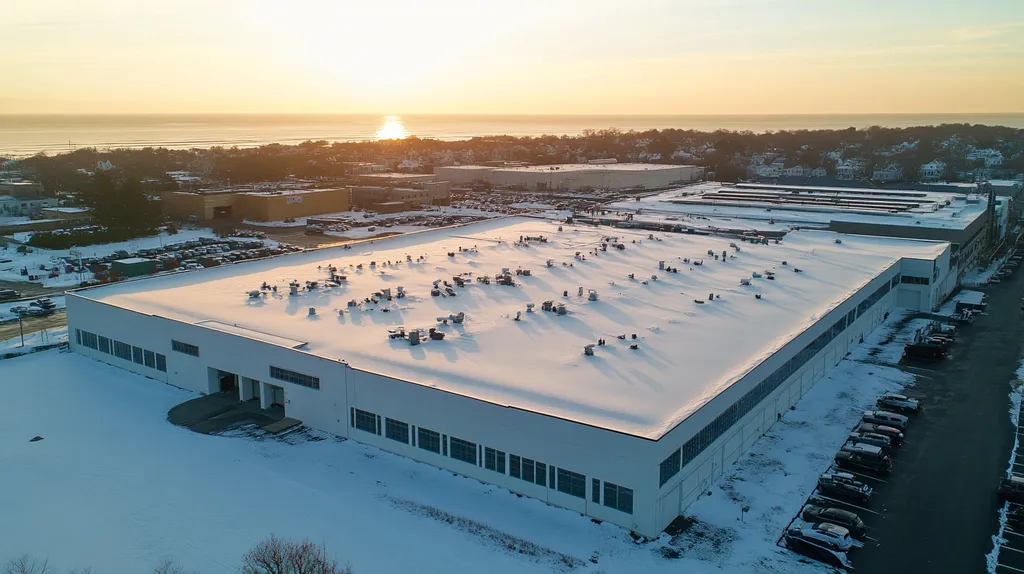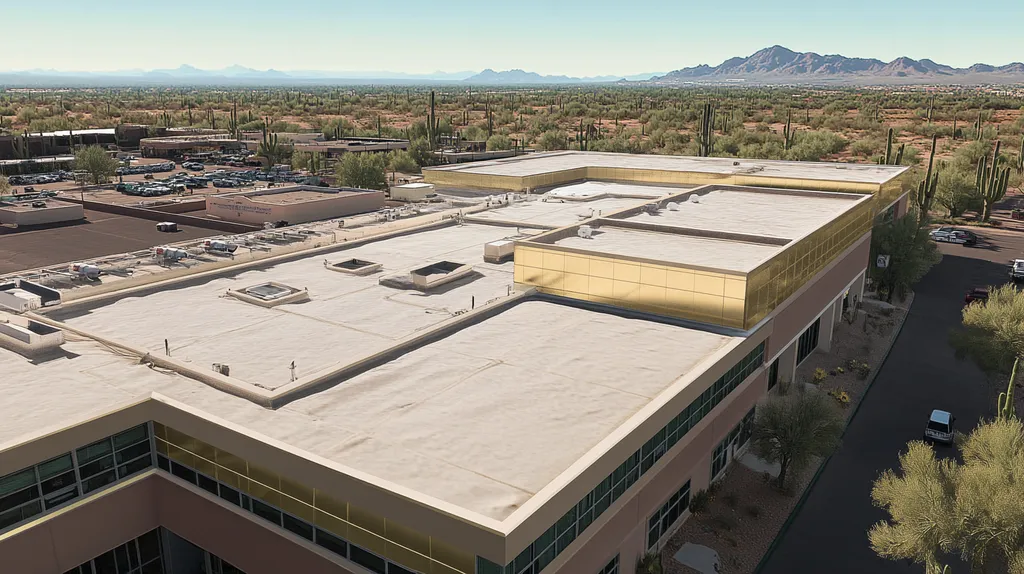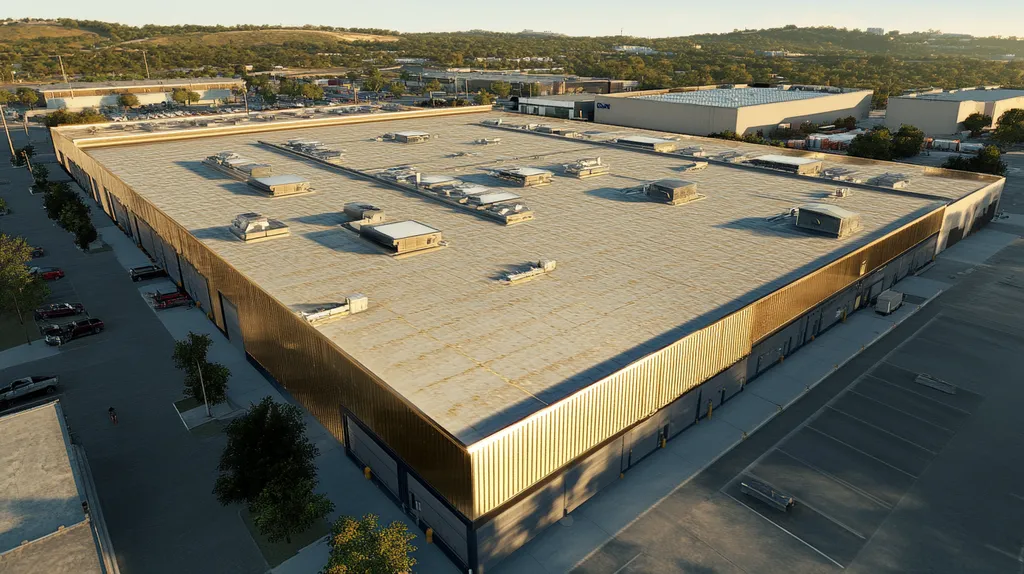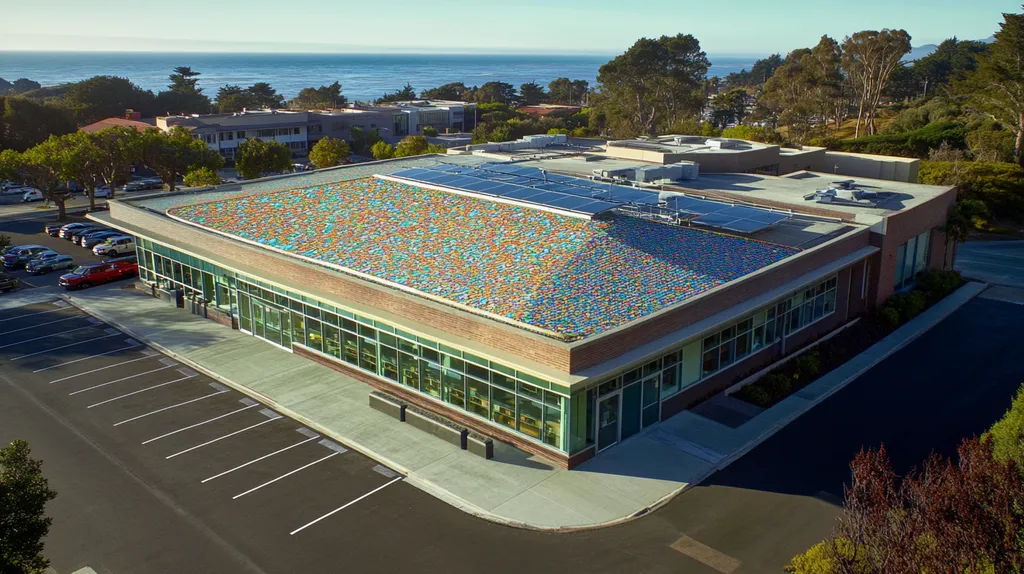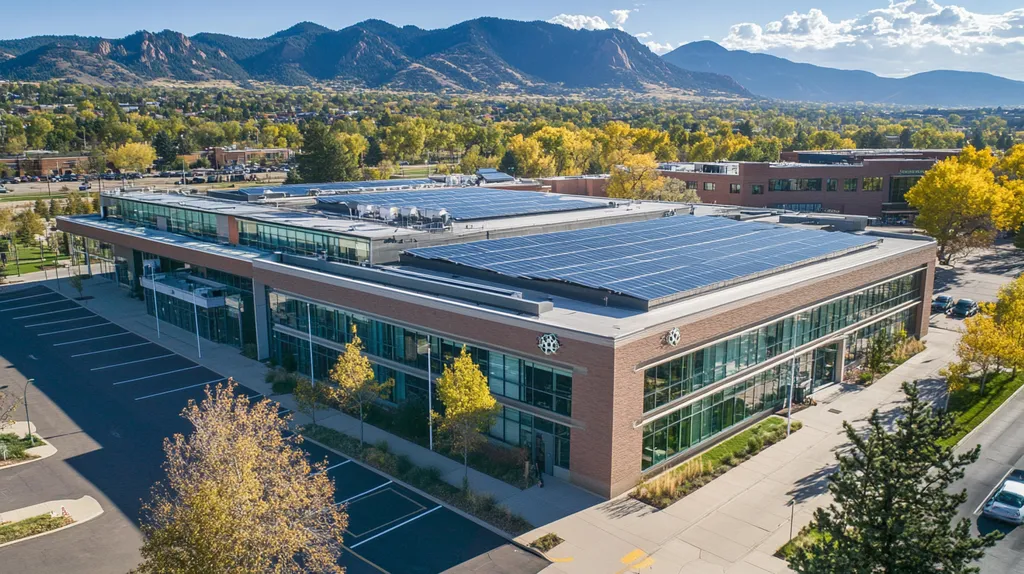Industry data reveals that 80% of commercial roofs fail prematurely due to inadequate inspection practices, particularly after protective coatings are applied. This oversight costs facility managers millions in preventable repairs annually.
While coating applications can extend roof life by up to 15 years, their effectiveness depends entirely on proper inspection frequency and maintenance protocols.
This article examines common misconceptions about inspection schedules, analyzes their costly implications, and provides evidence-based guidelines for maintaining coated commercial roofs. Understanding these factors is crucial for protecting valuable roofing investments and avoiding catastrophic failures.
SECTION 1: COMMON MISCONCEPTIONS
Understanding the true nature of commercial roofing maintenance is essential. Neglecting regular inspections may lead to expensive repairs, increased energy costs, and safety risks. According to the National Roofing Contractors Association (NRCA), engaging in proactive maintenance can extend the life of a roof by up to 50%. Facility managers and property owners need to recognize and address common myths around inspection frequency to safeguard their investments.
Myth: Roofs Are Maintenance-Free
Some facility managers mistakenly think that after a roof is installed, it requires minimal upkeep. This belief can have serious consequences; neglecting maintenance can trigger early failures. No matter the roof’s quality, it is vulnerable to environmental factors that necessitate regular care.
Weather elements—like UV rays, rain, and snow—gradually degrade roofing materials. Even newly coated roofs require periodic attention to ensure their protective layers remain effective. Implementing a consistent maintenance schedule can significantly reduce costs associated with unexpected repairs.
Regular inspections help facility managers avoid sudden leaks and structural vulnerabilities. A proactive maintenance strategy keeps roofs functioning at their best and extends their lifespan, emphasizing the critical need for scheduled care.
Overlooking the necessity of routine inspections only paves the way for larger issues and more significant repair costs. Recognizing that roofs require diligent monitoring is key for effective facility management.
Misconception: DIY Inspections Are Sufficient
While some facility managers may feel capable of performing their own roof inspections, this approach can overlook essential details that trained professionals are equipped to detect. Insufficient technical knowledge about roofing systems can lead to critical oversights that jeopardize a roof’s integrity.
Professional inspections utilize specialized tools and expertise absent in DIY efforts. For example, professionals can identify subtle signs of wear, such as membrane fatigue or hidden moisture, which inexperienced eyes might miss.
Moreover, relying solely on DIY inspections may result in compliance issues with safety standards and warranties. If a warranty requires inspections to be conducted by certified professionals and a facility manager undertakes a DIY approach, it may invalidate the warranty.
Investing in professional inspections ensures every aspect of the roofing system, especially after coatings, receives thorough evaluation. This proactive approach acts as a safeguard against costly future repairs.
Belief: Infrequent Inspections Are Adequate
A frequent misconception is that annual inspections are adequate for roof maintenance. However, commercial roofs endure various challenges throughout the seasons that necessitate more regular evaluations.
In areas subject to severe weather, like heavy storms or significant snowfall, conducting frequent inspections can detect damage before it worsens. This is crucial after extreme weather events when chipped coatings or loose materials can appear.
Infrequent inspections fail to account for how quickly small issues can escalate into major problems within just a few months, possibly leading to costly repairs.
For optimal protection, roofing experts advocate for inspections every six months. This frequency allows for early identification of issues, preventing potential disruptions to the facility’s operation or budget.
Ultimately, appreciating the necessity of more frequent evaluations is vital for maintaining a roof’s effectiveness and longevity. Regular professional inspections support compliance and encourage proactive facility management.
SECTION 2: PRACTICAL IMPLICATIONS
The importance of regular inspections becomes strikingly clear when considering the lasting impact on the lifespan and reliability of a commercial roof. Studies show that roofs subjected to systematic inspections can enjoy an extended lifespan of up to 30%. Understanding the practical implications of inspection frequency is crucial; it can be the difference between effective, proactive maintenance and unexpected, costly repairs.
Impact on Roof Lifespan and Durability
Consistent roof inspections significantly enhance the lifespan and durability of commercial roofs. Even coated roofs, which are built for resilience, require regular monitoring to catch early signs of wear. Without this vigilance, minor issues can escalate quickly, leading to both financial and time-intensive setbacks.
For instance, a small crack in the coating can allow moisture to seep in, compromising the integrity of the roof’s underlying structure. If unnoticed, this could escalate to severe damage, necessitating costly repairs or even complete roof replacement. Regular inspections offer a cost-effective strategy for early detection and intervention.
Additionally, inspections pinpoint areas where the coating may be thinning. This proactive identification allows for timely re-coating, ensuring optimal roof performance for the long term.
Ultimately, prioritizing regular inspections aligns with an overarching maintenance strategy that emphasizes longevity, sustainability, and the protection of vital assets beneath the roof.
Consequences of Neglected Roof Issues
Neglecting routine inspections can lead to significant roof-related problems, impacting property owners negatively. When oversight is lacking, minor leaks can go unnoticed, triggering widespread damage that extends far beyond the roof.
The structural integrity of a building is at risk when moisture deterioration occurs undetected. This could lead to collapse hazards and pose safety risks to occupants. Facilities managers may also face litigation if failure to maintain the roof is deemed responsible for injuries or property damages, highlighting the critical need for consistent inspections.
Moreover, regular inspections can reveal issues affecting energy efficiency. Damage to the roof can lead to increased heating and cooling costs, creating a further strain on budgets.
Effects on Building Safety and Compliance
The condition of a commercial roof is integral to building safety and regulatory compliance. Skipping inspections can result in hazards that jeopardize occupants, such as falling debris from structural weaknesses or health risks due to mold growth.
Facility managers should be cognizant of building codes that require routine maintenance checks, including roofing inspections, to stay compliant. Failing to meet these regulations could lead to fines or operational shutdowns.
A compromised roof not only creates safety issues but can also affect workplace morale and contribute to higher insurance premiums if recognized as a risk factor.
In conclusion, the significance of regular roof inspections is paramount. They play an essential role in maintaining safety, ensuring compliance, and maximizing the efficiency of any commercial facility.
SECTION 3: COST OF MISINFORMATION
The impact of misinformation regarding commercial roof inspections can be profound. Facility managers often overlook the financial consequences of delaying essential repairs. Research indicates that a single leak, if neglected for a few months, can lead to repair costs exceeding $12,000. Misunderstandings about how frequently inspections should occur only exacerbate these costs, creating additional hurdles that affect a facility’s overall financial health.
Financial Burden of Delayed Repairs
The financial toll of skipping regular roof inspections can be overwhelming. A minor issue, like a crack in the coating, can quickly evolve into a major problem without prompt detection. Estimates reveal that for every dollar invested in proactive maintenance, organizations could save as much as $8 on future repairs.
Timely inspections allow facility managers to identify and address small problems before they escalate into significant leaks. Delayed action can lead to repair costs spiraling out of control, which drains budgets that could otherwise support essential facility operations.
Emergency repairs often disrupt normal business activities, further complicating budget management. Such interruptions can result in productivity losses that may take considerable time to recover from.
Being informed about inspection schedules is crucial for avoiding escalating financial consequences.
Increased Energy Consumption Costs
Misinformation surrounding roof inspections can inadvertently lead to higher energy costs for commercial properties. A roof that is not well-maintained typically fails to provide adequate insulation, causing heat to escape during winter and enter during summer. This forces HVAC systems to work harder, resulting in increased energy expenses.
Research indicates that energy costs can rise by approximately 3 to 5% for every degree change in indoor temperatures. Facilities that neglect regular roofing inspections risk significantly raising their energy bills.
Additionally, roofs that lack regular inspections and maintenance can develop insulation problems. This not only heightens energy costs but can create uncomfortable conditions for employees and tenants, further impacting productivity.
Regular inspections play a vital role in preserving energy efficiency and minimizing overall operational costs.
Insurance and Regulatory Non-Compliance Penalties
Failure to conduct adequate roof inspections can lead to serious insurance repercussions. Insurers often require evidence of routine maintenance; without this proof, claims may be denied. Consequently, property owners could be left liable for significant repair costs that should have been covered.
Moreover, local regulations frequently mandate roofing inspections at regular intervals. Non-compliance can result in fines and penalties, straining operational budgets. This potential liability emphasizes the need for facility managers to stay vigilant regarding maintenance requirements.
Regular inspections help ensure that roofing systems comply with both insurance and regulatory standards, protecting organizations from unnecessary legal troubles.
In summary, misinformation related to inspection frequency incurs costs that extend well beyond repair expenses. It also affects energy consumption, insurance dynamics, and compliance risks, underscoring the urgent need for accurate information and proactive management.
SECTION 4: REALITY CHECK
Regular inspections of commercial roofs are not just a best practice; they are critical for ensuring both longevity and performance. Alarmingly, over 30% of commercial roofs fail prematurely due to a lack of proper maintenance. This statistic highlights the urgent need for facility managers to implement consistent inspection schedules, particularly after applying new coatings. By addressing inspection frequency, businesses can save substantial repair costs and prevent operational disruptions.
Importance of Regular Inspections
Regular inspections function as a preventive measure to catch issues before they escalate into costly repairs. Coated commercial roofs require vigilant monitoring to ensure their protective layers remain intact. The integrity of the roof is essential for maintaining temperature control and safeguarding the building’s interior environment.
By establishing a routine inspection schedule, facility managers can identify and address wear, leaks, or punctures early on. This proactive approach not only reduces long-term maintenance costs but also extends the lifespan of the roof. Facilities that conduct regular inspections can save up to 50% on unforeseen repair expenses.
Moreover, consistent inspections enhance energy efficiency. A well-maintained roof minimizes thermal inefficiencies, which reduces energy costs and supports sustainability goals. This commitment to proactive roofing maintenance reflects a responsible management style that benefits the bottom line.
In conclusion, the critical role of routine inspections cannot be overstated. They are foundational to an effective roofing maintenance strategy, ensuring that coatings function optimally over their intended lifespan.
Role of Professional Inspectors
Engaging professional inspectors is vital for comprehensive evaluations of commercial roofs. These experts possess the training and tools needed to detect subtle issues that may evade untrained eyes. Their knowledge of various roofing materials, potential vulnerabilities, and appropriate inspection techniques is invaluable.
Professional inspectors utilize advanced technology, including infrared scans and moisture detection equipment, to accurately assess the roof’s condition and provide actionable recommendations. This structured approach offers a level of insight that is often unattainable through casual examinations.
Additionally, certified inspectors help maintain compliance with industry regulations. Non-compliance can result in costly fines and increased liability for facility managers, making their role even more significant.
Ultimately, hiring qualified inspectors ensures that roofs receive thorough and accurate evaluations. Their expertise acts as a protective layer, fostering confidence in the roof’s performance and longevity.
Factors Influencing Inspection Frequency
Several factors dictate how often a commercial roof should be inspected. The type of roofing system has a significant impact, as different materials have varying lifespans and maintenance requirements. Understanding these nuances allows for a more tailored approach to inspection schedules.
Environmental conditions also play a crucial role. Regions prone to severe weather, such as heavy storms or extreme temperatures, may necessitate more frequent inspections. Ignoring these environmental influences can lead to accelerated roof degradation and higher costs.
The roof’s age is another important consideration. Older roofs typically show signs of wear that require increased attention. Facility managers should adjust inspection frequency as roofs age to address these challenges effectively.
Lastly, any recent maintenance work or repairs should prompt an inspection. Post-maintenance evaluations ensure that work was completed properly and any emerging issues are identified promptly.
In summary, understanding these factors enables facility managers to develop a customized inspection schedule that aligns with their specific roofing needs, thereby optimizing performance and extending the roof’s service life.
SECTION 5: EVIDENCE-BASED ALTERNATIVES
Maintaining commercial roofs, especially post-coating, is crucial for safeguarding investments. Many facilities fall into the trap of relying on outdated inspection schedules, which can lead to missed deterioration and costly repairs. Establishing a structured approach to inspections is vital for preventing premature roof failures and enhancing overall performance. This section discusses effective strategies for optimizing roof inspections and maintenance through evidence-based alternatives.
Recommended Inspection Schedules
Creating an effective inspection schedule is essential to protect commercial roofs. Experts advise conducting inspections at least twice a year, typically in spring and fall, to align with seasonal weather changes that may impact roofing materials.
Moreover, it’s important to perform additional inspections following severe weather events, such as heavy storms or hail. Research indicates that roofs subjected to extreme conditions experience faster deterioration when not closely monitored. Neglecting post-storm inspections can allow minor issues to develop into significant leaks.
Proper documentation of each inspection is critical for future reference. Embracing a data-driven approach enables facility managers to identify and address problems proactively. This commitment not only enhances roof longevity but also maximizes the roof’s overall value.
Comprehensive Inspection Checklists
A detailed inspection checklist is vital for thoroughly evaluating roof conditions. Facility managers should include critical elements such as surface wear, membrane stability, and the functionality of drainage systems. Customizing each checklist to specific roofing types ensures a more precise assessment.
Using checklists promotes systematic evaluations and consistent reporting. For instance, if a checklist identifies granule loss on a coated roof, immediate action can be taken to prevent further deterioration. Regular updates to checklists enhance adaptability to advancements in roofing technologies.
Incorporating digital inspection platforms can streamline the checklist process, allowing for easy access to data. This advancement facilitates better communication among teams and supports informed maintenance decisions. Ultimately, thorough checklists significantly increase the chances of detecting issues early, thus avoiding costly repairs.
Benefits of Preventive Maintenance Plans
Implementing preventive maintenance plans is a strategic approach to effective roof management. Prioritizing maintenance helps preserve roof integrity while extending its lifespan. These well-structured plans often result in lower overall costs compared to reactionary repairs.
For instance, consistent cleaning of gutters and drains can greatly diminish water pooling, which is a prevalent cause of leaks. Neglected maintenance can lead to markedly higher repair expenses, as shown in studies comparing well-maintained roofs to those lacking regular care.
Furthermore, preventive maintenance contributes to improved energy efficiency by optimizing roofing systems. Effective roofs can significantly lower energy bills, translating into considerable savings over time and justifying the initial investment in preventive strategies.
In conclusion, investing in structured inspection schedules, comprehensive checklists, and preventive maintenance plans is critical for maximizing the longevity and performance of commercial roofs. These evidence-based alternatives protect assets and promote sustainable operational practices.
SECTION 6: TEST AND VERIFY
Effective management of commercial roofs hinges on thorough and regular inspections, particularly after coatings are applied. Alarming statistics reveal that nearly 30% of roof failures stem from insufficient maintenance and oversight. To avert potential crises, facility managers must emphasize pre-inspection preparations, meticulous documentation, and proactive follow-up actions. This strategic focus guarantees that every issue is detected and resolved before leading to costly repairs or permanent damage.
Pre-Inspection Preparation Steps
A successful roof inspection begins with careful preparation. Facility managers should compile a detailed checklist outlining all necessary tools and materials for the inspection. Essential items include safety gear, notepads for documentation, and digital cameras to capture images of any observed damage.
Reviewing the roof’s maintenance history also proves beneficial. By understanding past issues, managers can pinpoint trouble spots more efficiently during inspections, streamlining the process.
Timing the inspection for a dry season optimizes visibility and enhances safety. Clear weather provides a better view of the entire roof while minimizing risks associated with slippery surfaces.
Collaborating with experienced roofing professionals can significantly enhance the inspection’s efficacy. Their expertise often uncovers subtle issues that may go unnoticed by less experienced individuals.
Effective Documentation and Reporting
A systematic approach to documentation is crucial for effective roof management. Thorough notes should record inspection findings, highlighting areas of concern and recommended repairs. Consistent reporting formats facilitate easier tracking of recurring issues over time.
Incorporating photographic evidence strengthens documentation. Images serve as visual references for future inspections and aid stakeholders in grasping the roof’s condition and the urgency of necessary repairs.
Utilizing digital tools can streamline the documentation process. Maintenance reporting software organizes findings and sends reminders for upcoming inspections, ensuring nothing is overlooked.
Sharing comprehensive reports with all relevant parties promotes accountability and transparency. Open communication keeps everyone informed about the roof’s condition and the required follow-up actions.
Post-Inspection Action and Follow-Up Procedures
Immediate action is crucial after an inspection to address any identified issues. Timely repairs help prevent further damage and can prolong the roof’s lifespan. Prioritizing these repairs based on their urgency and potential impact is essential.
Scheduling follow-up inspections for areas that needed attention ensures that repairs are effective and any emerging issues are caught early. This proactive approach fortifies the overall health of the roofing system.
Engaging in discussions with the maintenance team regarding inspection findings fosters collaborative problem-solving. This dialogue can generate innovative solutions and enhance long-term planning for the roof’s upkeep.
Finally, revisiting and updating the maintenance plan based on inspection outcomes facilitates proactive management. Applying lessons learned ensures that future inspections are increasingly focused and efficient.
The Bottom Line
Statistics reveal that proper inspection frequency can extend a coated commercial roof’s lifespan by up to 25 years, while inadequate oversight leads to premature failure in 80% of cases.
The evidence clearly demonstrates that bi-annual professional inspections, supplemented by additional checks after severe weather events, represent the minimum standard for protecting these vital assets.
Facility managers must abandon outdated beliefs about maintenance-free roofing systems and implement documented inspection protocols that include pre-inspection preparation, thorough documentation, and swift follow-up actions.
The financial implications of neglecting regular inspections – including repair costs averaging $12,000 per incident, increased energy expenses, and potential insurance claim denials – make this a business-critical issue requiring immediate attention.
In today’s challenging economic climate, protecting commercial roofing investments through proper inspection frequency isn’t just prudent – it’s essential for operational continuity and fiscal responsibility.
FREQUENTLY ASKED QUESTIONS
Q. What common myths exist about commercial roof maintenance?
A. One common myth is that commercial roofs are maintenance-free after installation. This belief can lead to unexpected failures and costly repairs. Regular inspections are crucial regardless of roofing material to ensure its longevity and effectiveness against environmental damage.
Q. How does inspection frequency impact commercial roof lifespan?
A. Regular inspections can extend a commercial roof’s lifespan significantly. These evaluations help identify minor issues before they progress into major problems, ultimately enhancing durability and reducing unexpected repair costs associated with neglect.
Q. What are the costs of neglecting commercial roof inspections?
A. Neglecting inspections can lead to significant repair costs, with small issues potentially escalating quickly. Studies indicate that timely inspections can save considerable money by preventing major damages and reducing the likelihood of expensive emergency repairs.
Q. Why are professional inspections recommended for commercial roofs?
A. Professional inspectors are trained to detect subtle issues that may go unnoticed by untrained individuals. They have access to specialized tools and can ensure compliance with regulations, ultimately providing a more thorough evaluation and preventing costly faults.
Q. What factors influence how often I should inspect my industrial roof?
A. Factors include the roofing material, environmental conditions, age of the roof, and any recent maintenance. Higher risks from severe weather may require more frequent inspections to ensure the roof remains in good condition and to prevent issues.
Q. What benefits come from a structured inspection schedule?
A. A structured inspection schedule promotes proactive maintenance, catching potential problems early. This practice not only boosts the roof’s longevity but also optimizes energy efficiency and reduces overall operational costs, leading to significant savings over time.
Q. How can facility managers ensure proper follow-up after roof inspections?
A. Facility managers should prioritize immediate action on identified issues and schedule follow-up inspections to assess repairs. Effective communication with maintenance teams regarding inspection findings is also essential for collaborative problem-solving and maintaining a proactive maintenance strategy.


